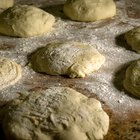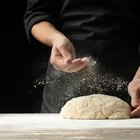karandaev/iStock/GettyImages
Fragrant, tender and chewy, the ideal homemade bread can be elusive. Even if you're an experienced baker, you may find that the same recipe never turns out exactly the same way twice. The reason is that atmospheric changes can alter the bread's taste and texture. In general, a dry, crumbly loaf is caused by too much flour, too much yeast or too long a rising period. Through trial and error, learn to adjust your baking techniques for the perfect loaf every time.
Use only as much yeast as indicated by the recipe. Using too much yeast causes the dough to rise rapidly, which can produce a crumbly loaf or a strong yeast flavor.
Start with the minimum amount of flour and add only as much as necessary to create a dough that's soft and smooth -- not sticky or dry. One of the main reasons yeast breads become crumbly is that the dough contains too much flour. On humid days, use more flour; on dry days, use less.
Cover the bowl with a clean kitchen towel and place it in a warm location. The ideal temperature for raising yeast dough is between 75 and 85 degrees Fahrenheit. If the dough is too warm, it will rise too quickly, creating a dry, crumbly loaf. In a cold, drafty place, the bread rises slowly or not at all, creating a soggy, dense loaf.
Check the dough after 45 minutes to one hour. It should have almost doubled in size. Punch a finger into the dough. If the indentation remains, the dough is done. If not, let it rise for a few more minutes. Keep checking the dough, because if you let it rise too much, it may become dry and crumbly. Most bread doughs rise within one to two hours.
Preheat the oven for at least 20 to 30 minutes, according to the temperature indicated in your recipe. Bread is best cooked at high heat -- between 375 and 450 F. This high heat creates a crispy crust and allows steam to develop inside the bread. This steam makes a moist bread.
Transfer the bread to a cooling rack and allow it to cool completely before you slice it. Slicing it while it's still piping hot allows steam to escape, which can dry out the bread.
Reduce the amount of yeast in a recipe by 25 percent, and reduce the rise times, too, if you live 1,000 feet above sea level or more. High altitudes can cause dry, crumbly bread, because it rises more quickly.
Combine the wet and dry ingredients separately, then combine them with a light hand when making quick breads. Overmixing quick breads can toughen them. Use baking powder along with, or instead of, baking soda, because baking powder tends to produce a finer crumb. Cook quick breads just until a toothpick inserted in the middle comes out clean.
Related Articles
How to Keep Crusty Italian Bread Soft

Why Bread Dough Does Not Rise

Why Does Bread Drop in the Middle When ...

What Happens if You Leave Bread Dough ...

How to Use a Bread Machine to Make Dough

How to Make Light Airy Italian Bread ...

Does It Matter if I Substitute Baking ...
Does French Bread Stale Quickly Because ...

Can Fast Acting Yeast Be Used in Place ...

Can You Refrigerate Homemade Yeast ...
Quick and Easy French Bread Recipe

Does Unbleached Bread Flour Make ...

How to Make Pasta Dura Bread

Can You Substitute Yogurt for Milk in ...

How to Bake With Besan Flour

How to Make Pumpkin Bread Moist

How to Increase the Yeast Taste in Bread

Quick Method for Thawing Frozen Bread ...

How to Bake Bread in a Clay Pot
How to Make Homemade Bread
References
- King Arthur Flour: Yeast Bread Primer
- Williams-Sonoma Essentials of Baking; Cathy Burgett
- Red Star Yeast: Rising and Ripe Test
- King Arthur Flour: High-Altitude Baking
- Fine Cooking: Better Cooking Through Convection
Tips
- If you use a convection oven for baking, reduce the temperature by 25 degrees and reduce the cooking time by 25 percent.
Writer Bio
Julie Christensen is a food writer, caterer, and mom-chef. She's the creator of MarmaladeMom.org, dedicated to family fun and delicious food, and released a book titled "More Than Pot Roast: Fast, Fresh Slow Cooker Recipes."